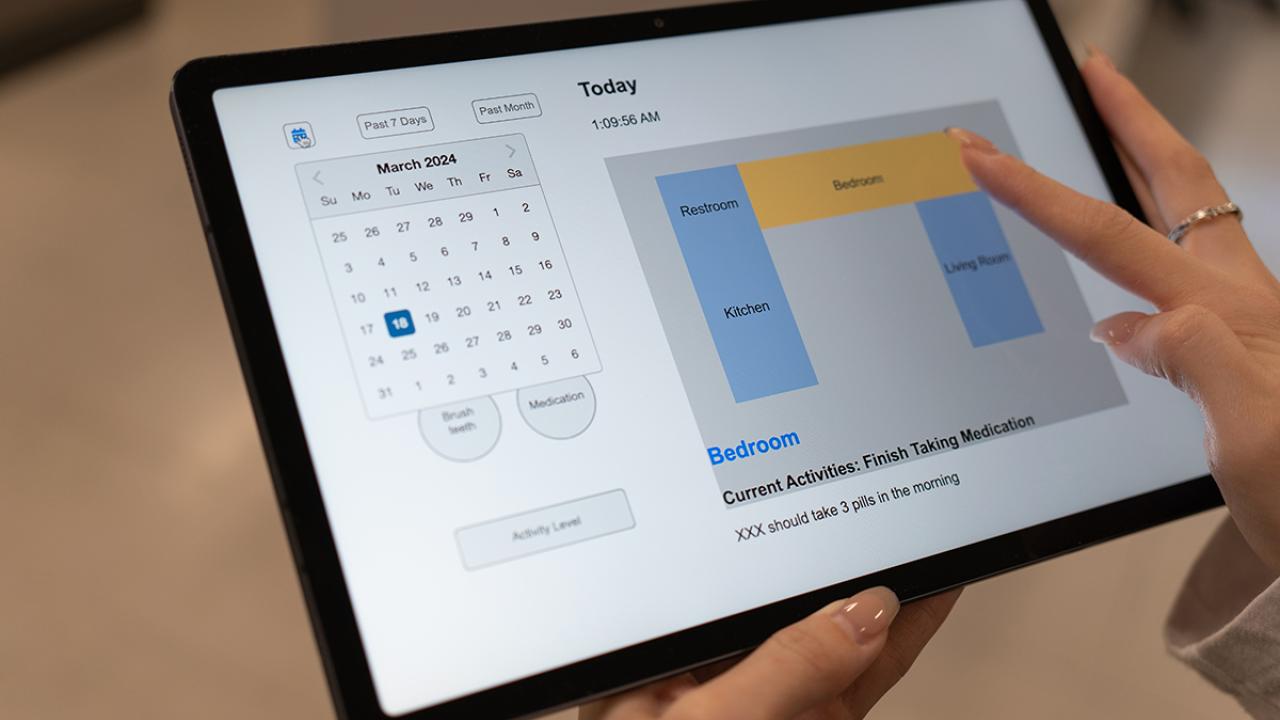
Hao-Chuan Wang Puts Humans at the Center of Technology Design

For Hao-Chuan Wang, human-computer interaction isn't about designing a cool-looking app. It's about finding the best way for humans and technology to collaborate.
"Collaboration is sometimes the hardest thing to address," said Wang, who researches human-centered design of collaborative systems as an associate professor of computer science at the University of California, Davis. "But with collaborative systems, you see a real impact on large, difficult problems. We can't run on individual work. It's fundamental."
Giving Agency Back to the Aging
Take Wang's work with the Interactive Care Platform, or I-Care. As part of UC Davis's Healthy Aging in a Digital World initiative, Wang is working with UC Davis Health researchers, including Alyssa Weakley, an assistant professor of neurology, and investigators from other institutions to develop a comprehensive system of data, sensors and user interfaces to connect aging adults with cognitive impairment to their caregivers.
The system comprises sensors, about the size of a prescription pill bottle, that are installed in a person's home. The sensors read the vibrations of various activities like getting out of bed or taking their medication, basically creating a map of a person's daily activities. That data is fed into machine learning algorithms that analyze it and turn it into readable information for both the patient and the caregiver, who might be hundreds of miles away. This is where Wang comes in.
Wang's goal of translating the data into legible information is to make it as simple for the user as possible. He is cognizant of the mental decline of these patients, understanding that technology may be challenging for them to use or remember to use.

"When we say 'use,' it doesn't mean in the conventional sense when you think about an app," he said. "We don't want them to do anything, and you want the system to be as simple and non-intrusive as possible. Design is not necessarily about creating new things; design is more often about addressing constraints."
It's also about giving the users agency over their lives. I-Care would allow people to maintain their privacy; The sensors only capture vibrations when the patient moves around their home, like from the bedroom to the kitchen. They don't capture visual or audio information that could be sensitive or intrusive.
I-Care would also allow people to stay in their own homes for longer because family, friends, doctors and caregivers, who may be in the same area or town but might also be entirely remote, would be on the other end of the app receiving information about whether the patient took their medication or had a fall.
The project is in the pilot stage, and as it gains more support and collaborators, Wang is excited to see how his research and technology have a specific and direct impact on people's health.
"We are trying to solve people's problems in the real world, and healthcare is very complex," he said. "Ultimately, we are trying to answer the question, 'How can we help deliver care to people remotely?'"
Fake Reviews, Misinformation and Decision Making
Wang is also interested in people's health and safety in the online space. In the past couple of years, his research focus has shifted from creating new technologies to analyzing the technologies that already exist and exploring whether they serve our needs productively.
"Technology these days can be so troublesome," said Wang. "Questionable information is presented all the time, and people buy in and are deeply affected by this information. It's not just a technology issue; it's about what people want to see, how people speak, share and influence other people."
Take Amazon reviews, for instance. Wang's first paper on "social technology," or the digital tools that enable social interaction, was an experiment on how customer ratings and reviews influence a consumer's purchasing behavior.
Participants were provided with virtual reality, or VR, goggles wired with an electric circuit to read the electrical signals in the prefrontal cortex. Then, they were presented with a product in three different scenarios: first, the product was shown with only information, no ratings or reviews; second, the product was shown with information and ratings; lastly, with information, ratings and one positive and one negative review.


The researchers found that the subjects were heavily influenced in their decision-making and tended to look less favorably on the product with the addition of ratings and reviews. Additionally, the more information the subject was presented with, the more time it took to decide.
The brain scans also showed signs of cognitive dissonance, a psychological state in which someone may hold conflicting beliefs or feelings. The subjects generally liked the product at the beginning of the experiment, but as they saw negative ratings and reviews that were inconsistent with their initial thoughts, they felt uncomfortable.
This may not be a big deal when it comes to a personal product, but, as Wang points out, in the age of misinformation and fake customer reviews (the Federal Trade Commission recently issued a rule prohibiting false testimonials and reviews, including paying people to post bogus reviews), this could have massive consequences when the decision has more weight.
"What about something like voting or an important public decision?" said Wang. "Misinformation can make decision-making emotional, and people can become subject to manipulation. And then, when we think about intervention, can we let people know they are in a dangerous situation where they might be vulnerable?"
Keeping the "Human" in Human-Computer Interaction
For Wang, this research is crucial to the engineering design cycle of the technologies that have become inherent to human lives.
"A standard engineering design cycle is ideation, implementation, evaluation. If we don't complete the last part of the cycle, evaluation, we aren't doing our jobs."
Next on Wang's docket is a research project with Richard Huskey, an associate professor of communication and the cognitive science program at UC Davis, evaluating the nuances of group work and the question of "What is fair play?" using a multiplayer Tetris game.
At the core of Wang's past, present and future research is interaction. Humans and computers are inexplicably linked now, but the best practices of how we engage remain to be seen, and humans are an essential part of the equation.
"The thing about online communication is that technology is changeable," said Wang. "Once we have a better understanding of what's going on, we will be in a better position to solve the problems for people. And we need to keep studying people to improve the technology."
